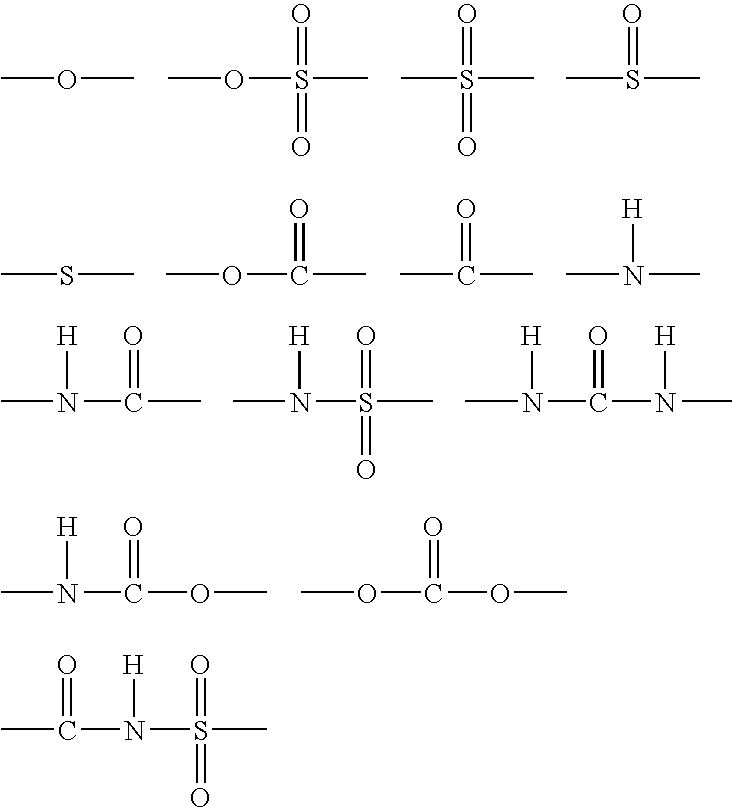Organic silicon compound, hydophilic composition containing the same and hydrophilic member
- Summary
- Abstract
- Description
- Claims
- Application Information
AI Technical Summary
Benefits of technology
Problems solved by technology
Method used
Image
Examples
synthesis example
Synthesis of Organic Silicon Compound (II-24)
[0039]A 500 ml three-neck flask was charged with 10.0 g of diisocyanate as shown below, 37.7 g of diamine as shown below, 0.05 g of bismuth tris(2-ethyl hexanoate) and 200 g of tetrahydrofuran, and refluxed for 7 hours. Thereafter 1.0 g of diisocyanate was further added thereto and refluxed for 7 hours. Thereafter 4.5 g of 3-aminopropyl triethoxy silane and 1.2 g of amino propane were added thereto and the resulting mixture was stirred for 6 hours at room temperature. Then it was put into 1.5 liter of ethyl acetate, the resulting precipitated solid matter was filtered off and washed with ethyl acetate to obtain an organic silicon compound having a structure of the exemplified compound (II-24). The weight thereof after having been dried was 39.5 g.
[0040]It was confirmed by 1H-NMR that the triethoxy silyl group (Si—OCH2CH3; 3.5 ppm) was introduced into one of the terminals. The weight average molecular weight of the polymer as measured by m...
synthesis example 1
Synthesis of the Organic Silicon Compound (I-1)
[0094]A 300 ml three-neck flask was charged with 30 g of polyethylene glycol, 2.05 g of 3-triethoxy silyl propyl isocyanate, 0.05 g of bismuth tris(2-ethyl hexanoate) and 150 g of tetrahydrofuran, and refluxed for 7 hours. The resulting mixture was put into 1.5 liter of hexane, and the resulting precipitated solid matter was filtered off and was washed with hexane to obtain an organic silicon compound having the structure of the exemplified compound (I-1). The weight thereof after having been dried was 27.6 g. It was confirmed by 1H-NMR that the triethoxy silyl group (Si—OCH2CH3; 3.5 ppm) was introduced into the terminal. The weight average molecular weight of the polymer as measured by means of GPC (with polyethylene oxide as a reference) was 4,000.
synthesis example 2
Synthesis of the Organic Silicon Compound (I-2)
[0095]With the exception of replacing polyethylene glycol (30 g) in the Synthesis Example 1 with polypropylene glycol (40 g), the same operation was carried out to obtain the exemplified compound (I-2). The weight thereof after having been dried was 36.4 g. It was confirmed by 1H-NMR that the triethoxy silyl group (Si—OCH2CH3; 3.5 ppm) was introduced into the terminal. The weight average molecular weight of the polymer as measured by means of GPC (with polyethylene oxide as a reference) was 4,000.
PUM
| Property | Measurement | Unit |
|---|---|---|
| Molecular weight | aaaaa | aaaaa |
| Hydrophilicity | aaaaa | aaaaa |
Abstract
Description
Claims
Application Information
 Login to View More
Login to View More - R&D
- Intellectual Property
- Life Sciences
- Materials
- Tech Scout
- Unparalleled Data Quality
- Higher Quality Content
- 60% Fewer Hallucinations
Browse by: Latest US Patents, China's latest patents, Technical Efficacy Thesaurus, Application Domain, Technology Topic, Popular Technical Reports.
© 2025 PatSnap. All rights reserved.Legal|Privacy policy|Modern Slavery Act Transparency Statement|Sitemap|About US| Contact US: help@patsnap.com



